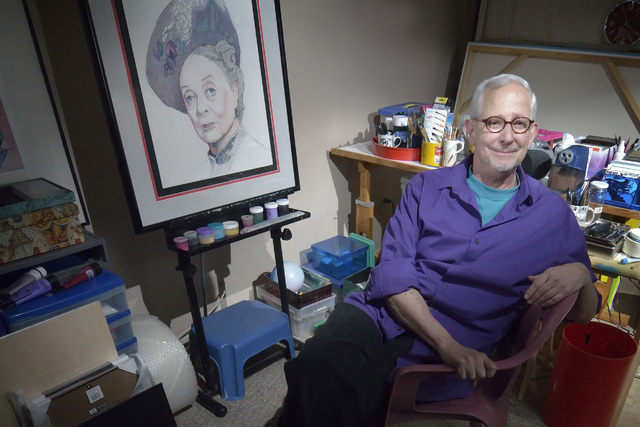Making people cry is a sign of success for artist Martin Kreloff
Artist Martin Kreloff has a bowl of big white buttons — the pin-on, campaign kind — on the coffee table in the living room of his vintage Vegas home, which doubles as his studio.
The buttons read, “I’m a friend of Marty Kreloff.”
Almost everybody is.
“If they’re not friends, almost everyone I’ve ever drawn has become a friend,” he notes.
Kreloff and Oscar-winning movie queen Joan Crawford were pen pals for five years. When he lived in Los Angeles, one of his best friends was “The Golden Girls’ ” Estelle Getty.
In Miami, where he lived for 25 years, Cary Grant saw his work and complimented him on his impressive resume, prompting Kreloff to respond, “ ‘Yes, but you’re Cary Grant’ ” — to which Grant replied, “ ‘People tell me that all the time.’ ”
A painting of underwater musical star Esther Williams — commissioned by a Miami film festival — prompted Williams to tell the artist it was “the happiest painting of her,” Kreloff recalls. “I told her, ‘You’re going to make me cry.’ And she said, ‘That’s what I’m aiming for.’ ”
When Kreloff met Broadway composer Stephen Sondheim — the subject of a portrait commissioned by Las Vegas-based David magazine — Kreloff told the legendary Tony-winner that he had a cat named Sondheim, prompting the cat’s namesake to burst into laughter.
And when Las Vegas’ own Matthew Gray Gubler (TV’s “Criminal Minds”) came to sit for a portrait, Kreloff started their session at the kitchen table, with a box of crayons.
“He’s an artist as well,” notes Kreloff, who told Gubler, “ ‘Let’s color together’ ” before taking the photographs that served as the basis for a portrait Gubler told Kreloff “ ‘captured my soul.’ ”
You can meet all these “friends of Marty” — and more, from his mother, as she looked when she graduated from high school in 1930, to his pool man’s soulful dog Bernie — at the Sahara West Library, where a 50-year retrospective of Kreloff’s Pop Art-influenced work continues through Aug. 6.
The exhibit charts Kreloff’s artistic journey, to be sure, but it also traces his life’s journey — from his Brooklyn boyhood to his 25 years in Miami (“where having a Brooklyn accent wasn’t a problem”), then California (“a couple years” in San Francisco, 14 in Los Angeles), then Las Vegas, where he’s lived for the past 12 years.
Kreloff moved to Miami in the late ’60s, accompanying his parents, who “thought it was the promised land,” he notes. “My dad asked, ‘Do you want to come to Florida — or do you want to freeze your ass off?’ ”
In Miami, Kreloff’s role in launching 1976’s “Miami Says Art” — photographs of more than 2,000 locals in the arts saying the word “art” — set the stage for the city becoming the North American headquarters of the Art Basel international art fair. (It also provided him with a role on TV’s “Miami Vice,” where he played a detective — not that he had any lines, but “I raised a mighty powerful eyebrow.”)
And, after a dozen years in Las Vegas, Kreloff, who’s now 71, believes “Las Vegas is very much where Miami was in the late ’60s — it’s about to explode, culturally.”
Kreloff’s life in art began long before then — back in Brooklyn, where he “started drawing at 5. I remember that clearly: I was on the floor, drawing,” and his mother came in, saw him in the process of creation, and asked, “ ‘Did you just do that? By yourself?’ ”
When he responded that he had, Kreloff’s mother replied, “ ‘Oh, my,’ ” he remembers. “Before the week was out,” a neighbor who worked as a fashion illustrator was instructing him. By 12, Kreloff was taking classes — life drawing classes. (“If you don’t think that’s embarrassing … ”)
As a New York kid, Kreloff was captivated by movies (he saw “Seven Brides for Seven Brothers” seven times) and Broadway. He adorned his bedroom with “a giant Mary Martin flying across the room as Peter Pan” — and stood by the stage door to get Ethel Merman’s autograph during her run in “Gypsy,” which featured lyrics by none other than future portrait subject Sondheim.)
After three years at the Parsons School of Design, Kreloff opted to join the working world — as a commercial artist creating bus and subway ads for such movies as the 1965 Western spoof “Cat Ballou.” (Kreloff dryly recites the ad’s tagline: “ ‘Cat Ballou’ ain’t no Puss in Boots.”)
Around that time, Kreloff also found his own artistic style.
In the years after World War II, abstract expressionism ruled the American art world, he points out, but in the 1960s, the Pop Art boom — led by such artists as Andy Warhol, Jasper Johns and Robert Rauschenberg — meant “you can paint movie stars and people will take it seriously,” Kreloff explains.
As “a second-generation pop artist,” as he describes himself, Kreloff is “a hard-edged painter,” creating distinct areas where “the color is mixed by the eye.” (In his portrait of Leonardo DiCaprio, for example, strips of purple, lavender, periwinkle, mauve, pink and beige form the actor’s face.)
“Every painting is a challenge beyond what you can see,” says Kreloff, who focuses on “looking beyond the eyes” of his subjects. “I paint the eyes in first. I know at that moment if I have the piece.”
As for capturing the likenesses of people he likes and admires, Kreloff admits that “I want to please them, but I don’t want to bend over backwards. There’s a balance between how they see themselves and how I see them.”
Along with pursuing his own art for decades, Kreloff has taught others — following his mother’s advice that “with talent comes responsibility.”
Sometimes he’ll see someone at First Friday and suggest, “ ‘Come to my studio and let me see if I can guide you.’ ” Sometimes he leads workshops; one he taught for Zappo’s employees focused on “Learning to See, Learning to Draw,” telling them art “is a magic wand. We’ll share some magic.”
And every time he does a portrait, “I’m totally the person I’m drawing,” explains Kreloff, who describes each painting as “a love affair — and then it ends.”
That is, until Kreloff unveils the portrait to the latest friend of Marty.
“Most times, when my paintings are unveiled,” the subjects “start to cry,” he notes. “The money is great, but crying is so powerful.”
Read more from Carol Cling at reviewjournal.com. Contact her at ccling@reviewjournal.com and follow @CarolSCling on Twitter.
Preview
What: "Martin Kreloff: A Retrospective"
When: 10 a.m.-8 p.m. Mondays through Thursdays, 10 a.m.-6 p.m. Fridays through Sundays, through Aug. 6
Where: Sahara West Library, 9600 W. Sahara Ave.
Admission: Free (702-507-6222; http://www.lvccld.org)































